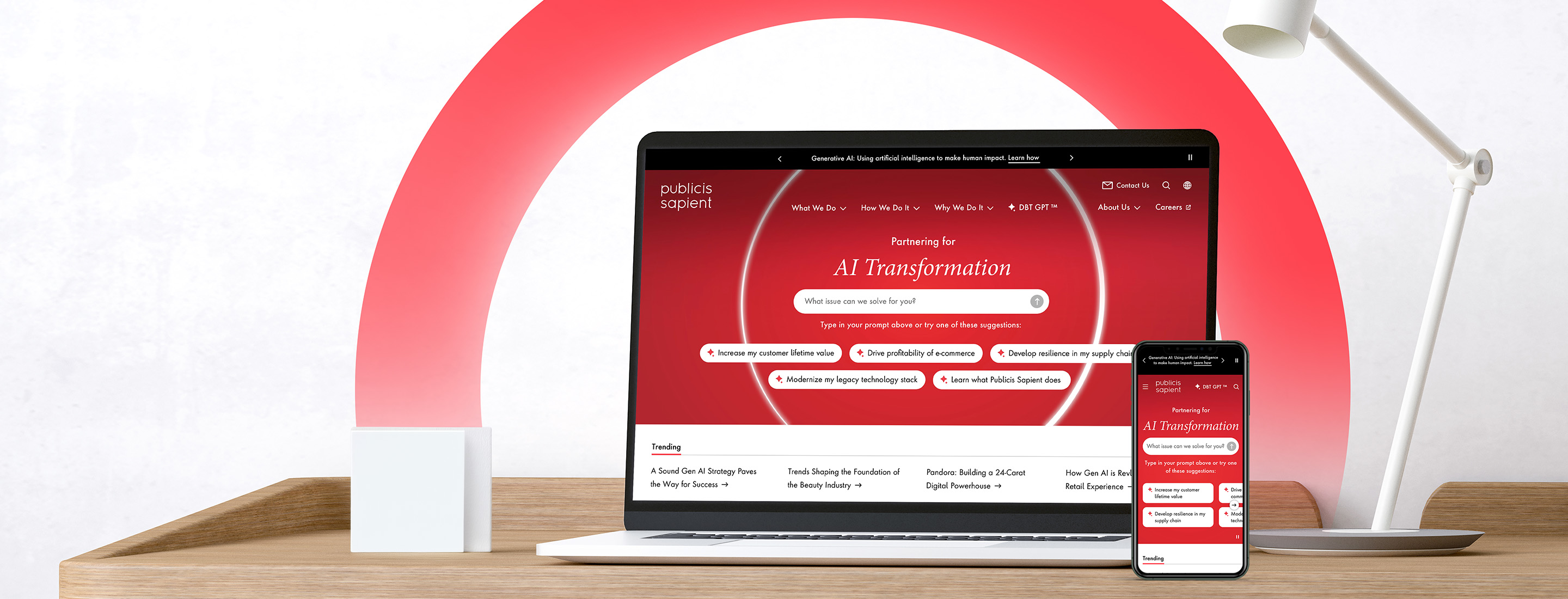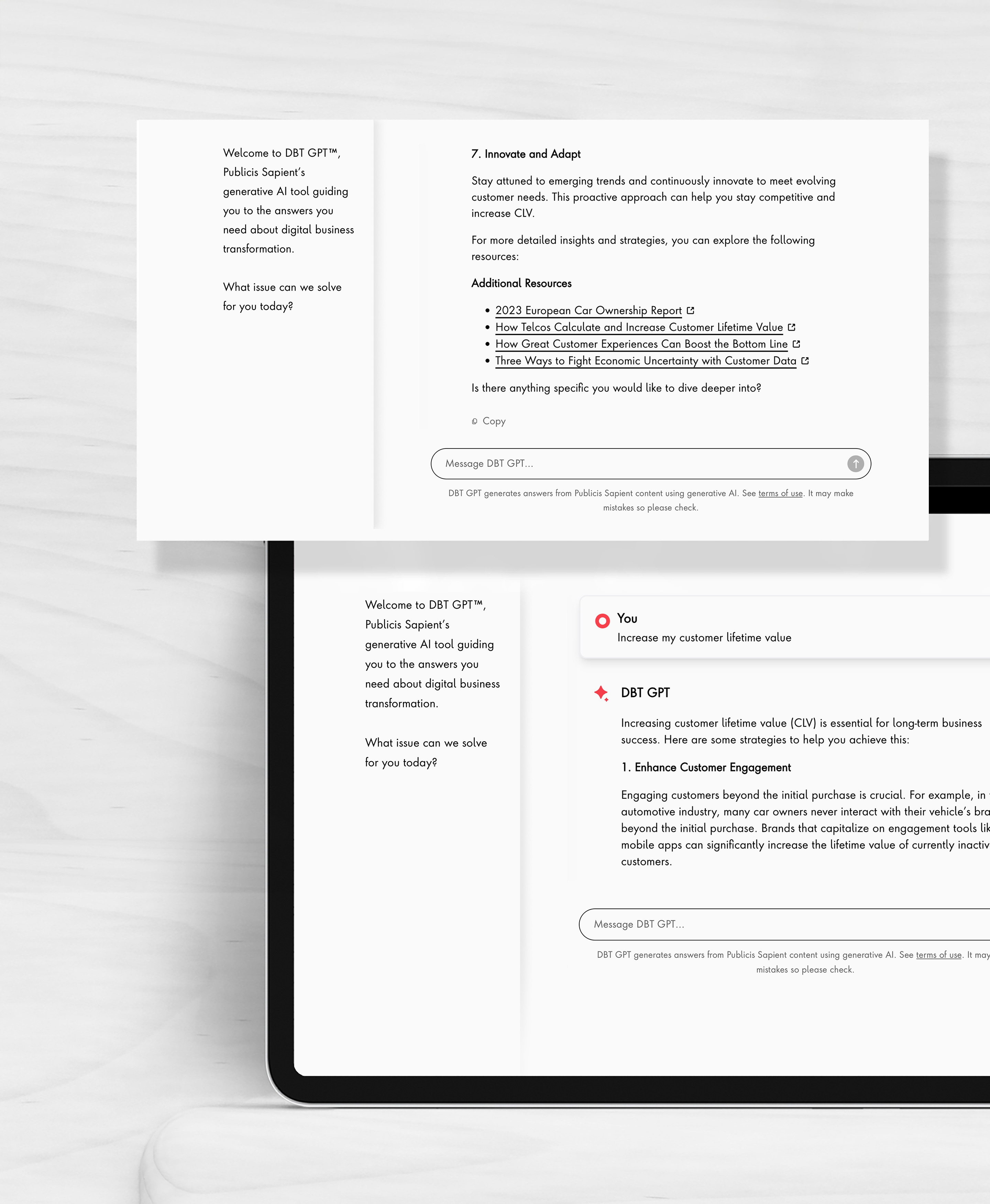What issue can we solve for you?
Type in your prompt above or try one of these suggestions
Suggested Prompt



Inside DBT GPT: Publicis Sapient’s Website AI Chatbot
Inside DBT GPT: Publicis Sapient’s Website AI Chatbot
Get a behind-the-scenes look at how and why we created DBT GPT, Publicis Sapient’s new conversational website AI chatbot.
Jodi Lyons Alex Kahn
As part of Publicis Sapient’s commitment to AI-driven innovation, our marketing team set out to embed a generative AI search experience into our website, publicissapient.com.
To explore the challenges, opportunities and development journey of this pioneering conversational tool called Digital Business Transformation GPT (DBT GPT), we spoke with Jodi Lyons, head of web at Publicis Sapient, and Alex Kahn, head of our innovation incubator, for an inside look.
Q: What is DBT GPT, Publicis Sapient’s conversational website AI chatbot?
Alex Kahn: DBT GPT is an AI chatbot that specializes in answering questions related to digital business transformation. Essentially, it’s a conversational AI search on our website that helps visitors consume information more efficiently by synthesizing the most relevant pieces of content tailored to their specific queries.

Q: How is DBT GPT different than other website AI chatbots or generative search tools?
Alex Kahn: If you go to ChatGPT and ask a question, you’re going to get a pretty generic response. But with DBT GPT, you’re going to see a response based on our thought leadership content, and it’s going to say, “For further reading, go check out this article,” if it makes sense to.
It does this through retrieval-augmented generation (RAG). Rather than building our own LLM from scratch, the RAG system allows us to keep the content retrieval within our own ecosystem, ensuring a more controlled and specific user experience. This approach not only enhances the efficiency of information retrieval but also makes the product unique to us.
Q: What were the main business cases for investing in DBT GPT?
Jodi Lyons: The primary motivation behind creating a website AI chatbot was our commitment to improving our visitor experience. We saw an opportunity for generative AI to help us do that.
This aligns with our strategic imperative to adopt, learn and embed AI into everything we do. Our clients are looking for help with AI, so we wanted to better represent the innovative AI solutions we can offer them.
- Help solve our clients’ problems: Our research on user behavior revealed that 60 percent of clicks on our site are related to finding out more about who we are and what we do. This indicates a significant interest from our visitors in understanding our identity and offerings. By integrating generative AI, we aim to provide faster and more direct access to this information, enhancing the user experience and reducing the need for multiple clicks.
- Make our content more accessible: One of the main challenges we face is the accessibility of our extensive content library, comprising over 1,000 pieces. Even though the answers to our users' problems might exist on our site, they are often hard to find. By incorporating generative AI, we can transform how information is accessed and synthesized, providing a more efficient and user-friendly solution directly on our website.
- Showcase what we can do with generative AI: The implementation of DBT GPT serves to demonstrate our expertise in generative AI, showcasing our ability to build and integrate AI solutions not just for our clients but for ourselves as well. This initiative underscores our speed to market and our commitment to staying at the forefront of AI innovation.
Q: How does DBT GPT enhance the user experience on your website?
Alex Kahn: We have, literally, thousands of thought leadership articles on our website that go in-depth about how to solve essentially any problem that a client or prospect would ever have. But sometimes, our site visitors don’t know the right questions to ask, so they might not find that content. So, DBT GPT is kind of like a bridge or a matching system between the needs of people who want these answers and the answers themselves.
DBT GPT offers a unique experience by not only providing long-form conversational responses but also infusing key artifacts from our website. This approach ensures that users receive synthesized, relevant information quickly, allowing them to delve deeper into our content. The goal is to help visitors find the answers they seek efficiently, potentially even bypassing the traditional site navigation experience.

Q: What insights do you expect to gain from the AI chatbot's data?
Jodi Lyons: We anticipate gaining valuable insights into user behavior and preferences. Unlike traditional search engines, which provide rudimentary data, the chatbot will offer detailed information about full-phrase questions and user intent. This data will help us understand what our constituents and site visitors are truly seeking, enabling us to tailor our content and solutions more effectively. We'll use these insights to inform product evolution, refine our value proposition and enhance our overall digital strategy.
Q: How do you measure the success of a website AI chatbot?
Jodi Lyons: Success will be measured through various metrics. We'll look at user engagement, content consumption rates and visitor satisfaction. Key performance indicators will include the number of searches conducted, time spent on the site, bounce rates and form submissions. We also aim to understand user behavior better through the data collected by the chatbot, which will provide deeper insights into what our visitors are seeking. This will help us continuously refine the tool and enhance its effectiveness.
Q: What are the future plans for DBT GPT's evolution?
Alex Kahn: While the creation of DBT GPT is exciting, it’s truly an MVP, and the bigger story is going to happen six months down the road when we discover how people really interact with this. And it won’t necessarily be a story about the DBT GPT product, but the way we approach marketing as a whole. For example, we have eight specific focus areas or issues that we believe our clients are facing, but DBT GPT may add color to that story and tell us that actually, most people are only searching for one. Or maybe they’re searching for that issue in a different way than we’ve been communicating about it.
The most valuable part of this tool is that it can get to the heart of what our clients care about, whereas engagement metrics and audience surveys only tell us part of the story.
Unlock Publicis Sapient’s exclusive risk management playbook for generative AI products
Q: What were the key steps to integrating the AI chatbot into the website?
Jodi Lyons: These are the general steps we went through, but really it was a nonlinear process.
Initial research and planning: The first month involved conducting a thorough discovery phase. This included analyzing web data, understanding the company's positioning and aligning on goals for the AI chatbot.
Design and development: The subsequent six to eight weeks focused on the actual development. This phase included designing the chatbot, integrating it with the website and ensuring that it met the project's core expectations and MVP (minimum viable product) criteria.
Choosing the technology: The decision to use a retrieval-augmented generation (RAG) system was a critical step. This technology retrieves and generates responses based on content specific to the company's ecosystem, which was crucial for maintaining control over the content and ensuring a more tailored user experience.
Iterative development and agile methodology: The development process was iterative, with agile methodology at its core. This approach involved short sprints, quick decision-making and continuous adjustments based on feedback, allowing the team to adapt swiftly to challenges and changes.
Testing and refinement: Testing was an integral part of the process, ensuring that the chatbot functioned correctly and met user needs. Feedback from these tests was used to refine the chatbot and improve its performance.
Implementation and launch: After development and testing, the chatbot was implemented and went live on the website. The launch involved monitoring its performance and making further adjustments as needed to enhance its effectiveness and user experience.
Future enhancements: Plans were made for future upgrades, including expanding the content available through the chatbot, integrating it with CRM systems for lead generation and continuously refining the tool based on user feedback and data insights.

Q: Did the development process involve any significant changes or pivots?
Jodi Lyons: Absolutely. The development process was truly iterative. From the initial concept to the final product, we faced several challenges that led to pivots. Our agile approach allowed us to make quick decisions in meetings without over deliberating. This was crucial in ensuring that the project moved forward smoothly and on time. We designed iteratively, chose the solution late-stage and modified the experience during the prototype phase, much like true iterative product development.
Q: What role did agile methodology play in the project?
Jodi Lyons: Agile methodology was at the heart of our development process. We adopted a best-in-class agile workflow with a small core team, short sprints and working sessions where decisions were made on the fly. Our steering team and CMO were kept apprised of the process, but we avoided lengthy approval processes or long review cycles with large groups of stakeholders. This approach enabled us to maintain momentum and adapt quickly to any challenges that arose, ensuring the project stayed on track and aligned with our goals.
Q: What advice do you have for other companies considering creating their own AI chatbot for their website?
Don't be afraid of the unknown: Embrace the learning process and don't be intimidated by unfamiliar concepts. Understanding the vernacular and specific tools involved is crucial, but once you grasp these, it becomes a standard product development task.
Maintain a clear vision: Clearly define what you want to achieve with the project. Knowing your vision helps break down the process into manageable steps and guides decision-making.
Leverage partnerships: Working with a dedicated external partner can accelerate the project, especially when internal resources are constrained. However, ensure that the partner's role is complementary to your team's capabilities.
Build with a product mindset: Apply your usual product execution approach, focusing on iterative development and agile methodologies. Don't hesitate to ask questions and seek clarity when needed.
Embrace agile and MVP mindsets: Focus on delivering an MVP and iterating based on feedback. This approach allows for faster deployment and continuous improvement.

Try DBT GPT to learn more about Publicis Sapient’s approach to AI transformation and how we are using artificial intelligence to solve complex problems across industries.
-
![]()
Solution
Sapient AI Solutions
Discover the power of generative AI through customized strategies that align with your needs, ensuring successful implementation and ethical practice.
-
![]()
Insight
Generative AI Risk Management Playbook
Unleash enterprise generative AI: Move prototypes to production and mitigate risk. Download our playbook
-
![]()
Case Study
Delivering Growth by Building a Global Home Rental Platform
How Marriott took the Homes & Villas short-term rental marketplace from MVP to full-scale platform in just six months.






